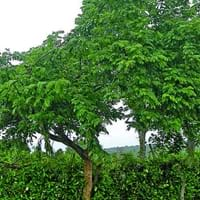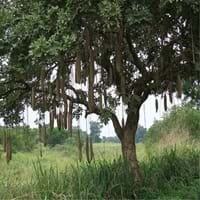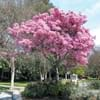Life Span
Perennial
Perennial
Origin
Mexico, Central America, South America
Eastern Africa, Middle Africa
Types
Not available
Not Available
Habitat
Subtropical climates, tropical environments, Tropical regions
Riverine forest, wooded grassland
USDA Hardiness Zone
10-15
9-12
Sunset Zone
H1, H2, 13, 23, 24
H1, H2, 12, 13, 19, 20, 21, 22, 23, 24
Habit
Oval or Rounded
Arching/Fountain-shaped
Flower Color
Pink, Light Pink
Dark Red, Tan
Flower Color Modifier
Bicolor
Bicolor
Fruit Color
Green, Chocolate
Tan
Leaf Color in Spring
Green
Green, Dark Green
Leaf Color in Summer
Green
Green, Dark Green
Leaf Color in Fall
Green
Green, Dark Green
Leaf Color in Winter
Green
Not Available
Leaf Shape
Pinnate
Pinnate
Plant Season
Spring
Spring, Summer, Fall, Winter
Sunlight
Full Sun, Partial Sun
Full Sun
Type of Soil
Loam, Sand
Loam, Sand
The pH of Soil
Acidic, Neutral, Alkaline
Acidic, Neutral, Alkaline
Soil Drainage
Average
Average
Bloom Time
Spring, Late Spring
Indeterminate
Tolerances
Drought, Dry Conditions
Drought, Salt
Where to Plant?
Ground
Ground
How to Plant?
Stem Cutting
Seedlings
Plant Maintenance
Low
Medium
Watering Requirements
Average Water Needs, Keep the ground moist but not water-logged
Needs a lot of water initially
In Summer
Lots of watering
Lots of watering
In Spring
Moderate
Moderate
In Winter
Average Water
Average Water
Soil pH
Acidic, Neutral, Alkaline
Acidic, Neutral, Alkaline
Soil Type
Loam, Sand
Loam, Sand
Soil Drainage Capacity
Average
Average
Sun Exposure
Full Sun, Partial Sun
Full Sun
Pruning
Remove damaged leaves, Remove dead branches, Remove dead leaves
Remove damaged leaves, Remove dead branches, Remove dead leaves
Fertilizers
All-Purpose Liquid Fertilizer, Fertilize in early spring, Nitrogen, Phosphorous, Potassium, Requires high amount of nitrogen
Balanced liquid fertilizer monthly
Pests and Diseases
Aphids, Brown Spots, Scab, Scorch
Leaf spot, Mealybugs, Rust
Plant Tolerance
Drought, Dry Conditions
Drought
Flower Petal Number
Single
Single
Showy Fruit
Not Available
Yes
Fragrant Flower
Not Available
Yes
Foliage Texture
Medium
Coarse
Foliage Sheen
Matte
Glossy
Attracts
Bees, Not Available
Bees, Birds, Butterflies, Not Available
Allergy
Not Available
Poisonous when unripe
Aesthetic Uses
Beautification, Showy Purposes
Not Used For Aesthetic Purpose
Beauty Benefits
Good for skin, Reduce Bruises
Acne, Slow downs aging
Environmental Uses
Agroforestry, Fixes Nitrogen, Insect Repellent, soil stabilisation
Air purification
Medicinal Uses
Antifungal, Cold, Expectorant, Fever, Rheumatism, Sedative, Ulcers
Gynaecological, Malaria, STDs
Part of Plant Used
Flowers
Dried seeds, Leaves
Other Uses
Cattle Fodder, Used as firewood, Wood is used for making furniture
Used to flavour beer, Used to produce a red dye
Used As Indoor Plant
No
No
Used As Outdoor Plant
Yes
Yes
Garden Design
Shade Trees, Street Trees, Tropical
Feature Plant, Shade Trees, Tropical
Botanical Name
GLIRICIDIA sepium
KIGELIA africana
Common Name
Mexican Lilac, Mother-of-coffee, Quickstick
Sausage Tree
In Hindi
QUICKSTICK
Sausage Tree
In German
QUICKSTICK
Sausage Tree
In French
QUICKSTICK
saucisse Arbre
In Spanish
QUICKSTICK
Árbol de salchicha
In Greek
QUICKSTICK
λουκάνικο δέντρο
In Portuguese
QuickStick
Árvore de salsicha
In Polish
QUICKSTICK
kiełbasa Drzewo
In Latin
Quickstick
farciminis ligno
Phylum
Magnoliophyta
Magnoliophyta
Class
Magnoliopsida
Magnoliopsida
Family
Fabaceae
Bignoniaceae
Genus
Gliricidia
Kaempferia
Clade
Angiosperms, Eudicots, Rosids
Angiosperms, Asterids, Eudicots
Subfamily
Faboideae
Not Available
Number of Species
Not Available
Season and Care of Quickstick and Sausage Tree
Season and care of Quickstick and Sausage Tree is important to know. While considering everything about Quickstick and Sausage Tree Care, growing season is an essential factor. Quickstick season is Spring and Sausage Tree season is Spring. The type of soil for Quickstick is Loam, Sand and for Sausage Tree is Loam, Sand while the PH of soil for Quickstick is Acidic, Neutral, Alkaline and for Sausage Tree is Acidic, Neutral, Alkaline.
Quickstick and Sausage Tree Physical Information
Quickstick and Sausage Tree physical information is very important for comparison. Quickstick height is 610.00 cm and width 460.00 cm whereas Sausage Tree height is 1,220.00 cm and width 910.00 cm. The color specification of Quickstick and Sausage Tree are as follows:
Quickstick flower color: Pink and Light Pink
Quickstick leaf color: Green
Sausage Tree flower color: Dark Red and Tan
- Sausage Tree leaf color: Green and Dark Green
Care of Quickstick and Sausage Tree
Care of Quickstick and Sausage Tree include pruning, fertilizers, watering etc. Quickstick pruning is done Remove damaged leaves, Remove dead branches and Remove dead leaves and Sausage Tree pruning is done Remove damaged leaves, Remove dead branches and Remove dead leaves. In summer Quickstick needs Lots of watering and in winter, it needs Average Water. Whereas, in summer Sausage Tree needs Lots of watering and in winter, it needs Average Water.





